AMD Athlon 64 X2 6000+: Competing with Aggressive Pricing
by Anand Lal Shimpi on February 20, 2007 3:37 PM EST- Posted in
- CPUs
General Performance
Although our usual general performance suites aren't available under Vista, something we often use in our motherboard reviews is: PCMark '05. PCMark is a somewhat unusual benchmark as it is a synthetic performance test that tries really hard to be applicable to the real world.
The tests used by PCMark '05 and the applications they are based off of are listed in the table below:
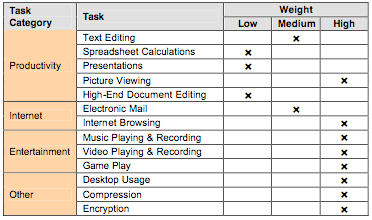
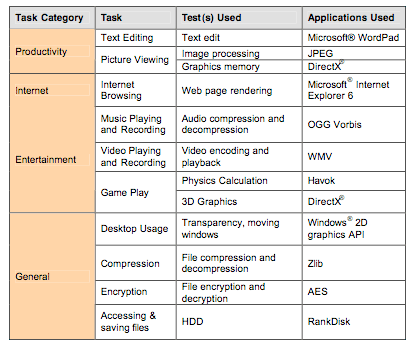
We focused on two of the PCMark tests: the system test suite and the CPU test suite. The system test suite is composed of the following tests:
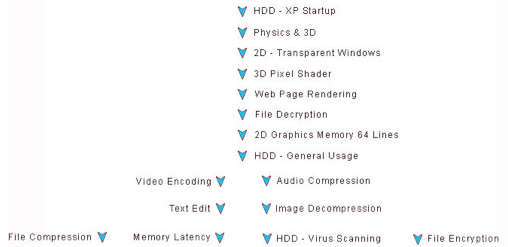
And the CPU test suite consists of the following tests:
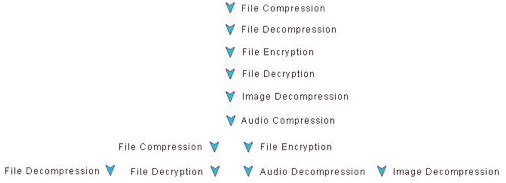
We reported the overall PCMark and CPU test scores.
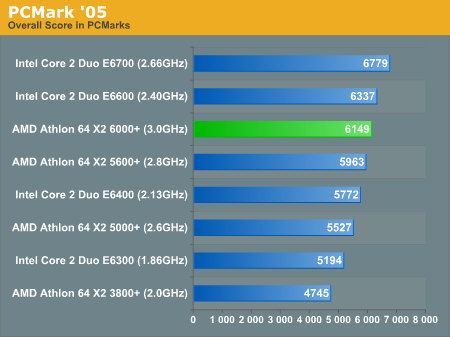
The overall PCMark '05 score indicates a clear victory for Intel, with both the E6700 and E6600 outperforming the Athlon 64 X2 6000+. The advantage is about 10%, but if we look at the CPU score things change a bit:
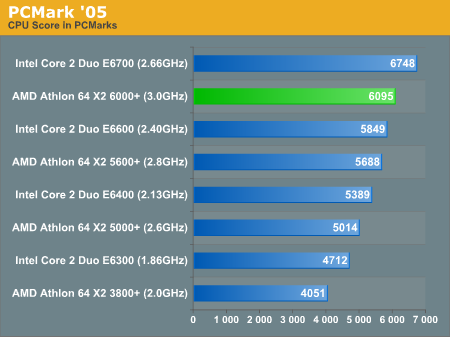
The E6700 is still on top, but the X2 6000+ manages to outperform the E6600. It's not a huge change and the tests are mostly grounded in real world applications, so the question is - will the trend hold up as we test individual applications?










34 Comments
View All Comments
defter - Wednesday, February 21, 2007 - link
The maximum measured 8800GTX power consumption is about 150W. NVidia has mentioned that absolute maximum is 180W. However, since this is a CPU review, it's logical to assume that they stressed only the CPU in "full load" power consumption test.poohbear - Wednesday, February 21, 2007 - link
wow so 260w load plus 50w for a 8800gtx, thats only 310wts! kinda strange when companies are selling 1kilowatt psus.:/poohbear - Tuesday, February 20, 2007 - link
i was gonna ask the exact same question. I wish they'd clarify that in the articles when they talk about power consumption. Is that 263wts under load for the 5600+ JUST for the cpu or the whole system? thanks for any of the writers who can clarify this 100%.JarredWalton - Tuesday, February 20, 2007 - link
Power reports are always for the entire system. Obviously, lower end GPUs would reduce total power requirements quite a bit, but in maximum load testing the stress is only on the CPU and not the GPU. Thus, the ~50W power difference is going to remain whether you're running an 8800 GTX or an X1300 SE. The latter would simply use probably 40-50W less total power.bamacre - Tuesday, February 20, 2007 - link
Add in OC'ing and Intel, still, jumps further in the lead.BladeVenom - Tuesday, February 20, 2007 - link
But most people don't overclock.ViRGE - Tuesday, February 20, 2007 - link
Many of the readers of this site do though. The C2D is so mind numbingly easy to overclock, it's hard to not do it.Roy2001 - Tuesday, February 20, 2007 - link
I agree. I never OCed before. But with E6400 it is so easy. I just changed FSB from 266 to 350, I have a 2.8Ghz C2D. No voltage change, no cooling change. That's easy.mino - Tuesday, February 20, 2007 - link
Not to mention 800FSB E4300 parts.2.66/333FSB is pretty much a safe bet on most boards.
Even 2.13 for $150 is nice with board at STOCK FSB!.
Who needs E6400 then :) (for stock performance).
poohbear - Tuesday, February 20, 2007 - link
well if a 2.4ghz C2D can beat a AMD64 @ 3.0ghz, then calling a C2D @ 3.2ghz (the average overclock from what im reading) the "king" processor is a monumental understatement. It'd rape the 6000+.